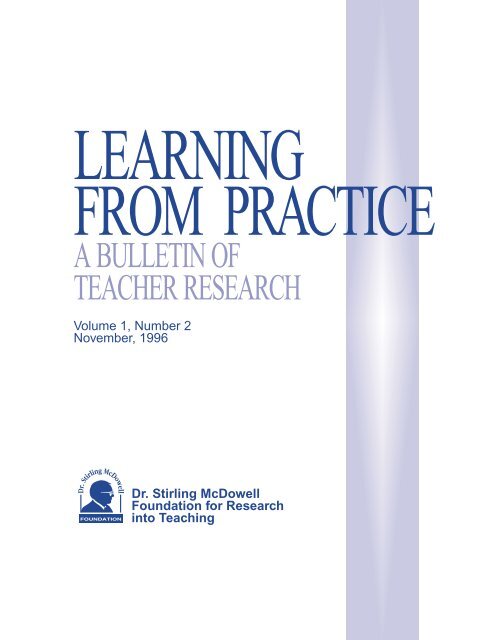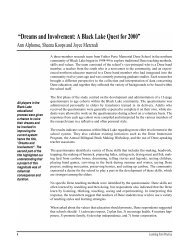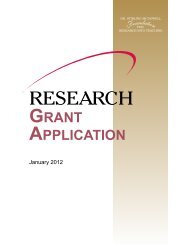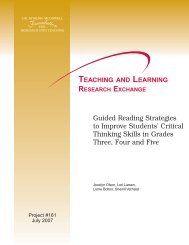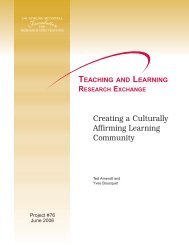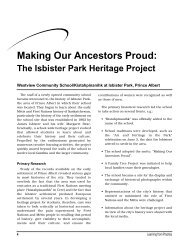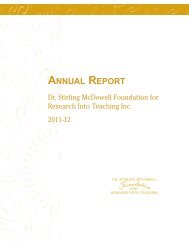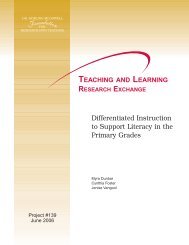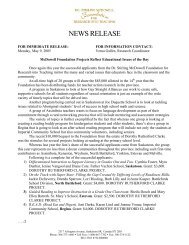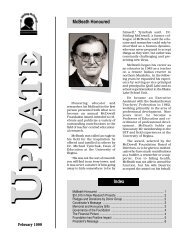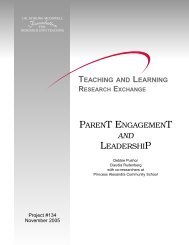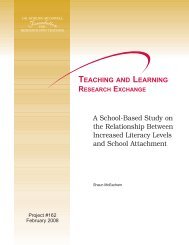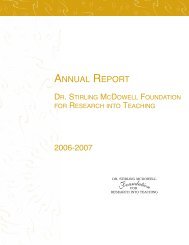Research Bulletin, Vol. 1, No. 2, 1996 - Dr. Stirling McDowell ...
Research Bulletin, Vol. 1, No. 2, 1996 - Dr. Stirling McDowell ...
Research Bulletin, Vol. 1, No. 2, 1996 - Dr. Stirling McDowell ...
Create successful ePaper yourself
Turn your PDF publications into a flip-book with our unique Google optimized e-Paper software.
LEARNINGFROM PRACTICEA BULLETIN OFTEACHER RESEARCH<strong>Vol</strong>ume 1, Number 2<strong>No</strong>vember, <strong>1996</strong><strong>Dr</strong>. <strong>Stirling</strong> <strong>McDowell</strong>Foundation for <strong>Research</strong>into Teaching
Learning from Practice: A <strong>Bulletin</strong> of Teacher <strong>Research</strong><strong>Vol</strong>ume 1, Number 2, <strong>No</strong>vember, <strong>1996</strong>Editor: Verna Gallén, <strong>McDowell</strong> Foundation <strong>Research</strong> CoordinatorCopyright <strong>1996</strong><strong>Dr</strong>. <strong>Stirling</strong> <strong>McDowell</strong> Foundation for <strong>Research</strong> into TeachingSaskatoon, SaskatchewanPhotos: Patti Avery, Shannon Booth, Janice Hendry, Lillian Forsythe, LawrenceMcMahen, Lorraine Stephanson, Beth Warkentin<strong>No</strong>te: Teachers are encouraged to reproduce the contents of this bulletin for professionaldevelopment or teaching purposes, with the understanding that they will give dueacknowledgement to the <strong>McDowell</strong> Foundation and the researchers in any use of thematerial.AcknowledgementsThe <strong>McDowell</strong> Foundation gratefully acknowledges the contributions and supportreceived from:• its Board of Directors, Project Review Committee and Advisory Committee,• the Saskatchewan Teachers’ Federation, and• donors to the Foundation, including those who have given foundational gifts -Greystone Capital Management, Gauley and Co., and the Teachers’ Credit Union.
<strong>Bulletin</strong>: <strong>McDowell</strong> Foundation Year Two<strong>No</strong>vember <strong>1996</strong>The <strong>McDowell</strong> Foundation has now funded 31 research projects, which are in variousstages of completion across the province. A list of projects for which final results areavailable and those which are currently in progress is provided on pages 33 and 34. Thisyear’s research bulletin highlights seven projects completed in 1995-96.The descriptions given of these projects are drawn from the longer research reports andexecutive summaries that each completed project submits to the <strong>McDowell</strong> Foundation.Excerpting heavily from the researchers’ writings, we have attempted to emphasize certainfindings and implications. However, the objective is not to replace the researchers’reports with shorter versions, but to acquaint the readers of this bulletin with the projectsthat have been done and encourage them to obtain the complete results. Information forobtaining <strong>McDowell</strong> Foundation research project reports through the Stewart ResourcesCentre is provided at the back of the bulletin.In just three years, teachers and others, with the assistance of the <strong>McDowell</strong> Foundation,have created an impressive body of research into teaching and learning. They have undertakenprojects in such areas as violence, literacy, Aboriginal and cross-cultural education,gender equity, the environment, the attitudes and behaviour of students, children with specialneeds, the structure and processes of the school itself, and new instructionalapproaches for various subjects and age groups. The results indicate that the <strong>McDowell</strong>Foundation is meeting its goal of assisting teachers to tackle through research a widerange of issues of importance in education.The purpose of the Foundation is to fund research, inquiry and the dissemination of informationthat focuses on teaching and learning and leads to the improvement of education inthe context of the K-12 public education system. It was created through the efforts of theSaskatchewan Teachers’ Federation to meet the need expressed by many teachers for educationalresearch that is oriented towards the classroom teacher.For some teachers, the <strong>McDowell</strong> Foundation also provides an avenue for pursuing selfdirectedand meaningful professional development. In the creation of action researchprojects on areas of interest, teachers reflect on their own teaching practices, identify problemsand opportunities for improvement, and share with colleagues their experiences,insights and ideas about teaching and learning. The personal and professional growthexperienced as part of the research process underlies the accounts that many <strong>McDowell</strong>Foundation researchers give of their research projects.In addition to the report descriptions, this bulletin features articles related to the<strong>McDowell</strong> Foundation’s second annual Learning from Practice seminar, held inSaskatoon, <strong>No</strong>vember 29-30, <strong>1996</strong>. One article is drawn from the keynote address givenby <strong>McDowell</strong> Foundation researcher, George Falk; and another highlights the remarks ofDavid Friesen of the University of Regina in synthesizing the events and discussions at theseminar.Learning from Practice 1
“I first thought thatit would be impossiblefor me to doresearch when I hadonly been teachingfor threeyears....The positiveimpact on my personallife and careerhas been tremendous.”contracts, peer coaching (Phys. Ed.), and integrated studies. Student assessment was carriedout through anecdotal notes, tests and quizzes, with students in cooperative groupsgiven a group mark as well as individual marks. Process was as much a consideration asproduct, and students were always involved in the planning and implementation of learningand aspects of assessment and evaluation. Every effort was made to individualizeprograms to meet diverse student needs. The teacher took the role of facilitator, constantlycirculating throughout the classroom, clarifying questions, challenging students andextending learning.Warkentin visited the classes as often as possible, and also held planning and discussionsessions with Hendry over the telephone. Her role in the project was to take a more theoreticalperspective and support Hendry’s experiential teaching with literature, material,and resources. Together the researchers discussed what worked and what didn’t, and why.With the consent of students, parents and administrators, they also collected data on theimpact of the experiential learning strategies in Hendry’s classes. Data collection took theform of classroom videotapes, field notes, students’ reflective journals, work samples, testresults, interviews, and questionnaires for students and parents.Students take their learning outside the classroom.ConclusionsFrom the data collected, the researchers conclude that “there was overwhelming evidenceindicating the positive impact of an experiential/active learning curriculum for secondarystudents.” Whether gathered around the classroom computer centre during the noon breakto talk and work on assignments, or planning and carrying out impressive Grade 12 graduationceremonies, the students involved in the project appeared responsible, confident,self-reliant and caring. They “became independent, responsible, self-motivated problemsolvers and critical thinkers who were, above all else, excited about learning. The greatestimpact was the building of self-confidence; the students were not afraid to voice theirthoughts and opinions, to share ideas and help each other.” The average marks achievedby the students in Hendry’s classes were high, and students’ preference for an experientiallearning approach was clearly and enthusiastically expressed in their questionnaires. InLearning from Practice 5
comparing the written feedback from students’ and parents’ questionnaires to the criteriafor experiential teaching and learning provided in the “Vision for Saskatchewan SecondarySchools,” the researchers found statements that addressed almost every criterion.“What we have tolearn to do we learnby doing.”AristotleThey noted, however, that few parents responded to the questionnaire. Conversations witha number of parents indicated that they did not feel they knew enough about the teachingapproaches to make meaningful comments. Hendry and Warkentin believe this lack ofknowledge needs to be addressed and recommend further efforts to make parents aware ofthe types of teaching methods and strategies being used in their children’s classrooms.Both researchers report a tremendous positive impact on their lives and careers from theirinvolvement in a collaborative research project. According to Hendry, “the opportunity toreflect in greater depth on my teaching methods” and “to interact with individuals on aprofessional basis at conferences allowed me to grow intellectually and gain knowledge ofdifferent research methods that have enhanced the final outcome of our research.” ForWarkentin, the “project was one of the most rewarding and exciting educational endeavoursof my 35 year career in teaching. To see experiential teaching and learning in actionat the secondary level and to see it ‘really work’ was quite an overwhelming experience.”Hendry and Warkentin hope that their colleagues will undertake similar action researchprojects in order to improve upon teaching practice in Saskatchewan high schools. Toencourage educators’ interest in experiential learning, they have produced a video andhandbook entitled “Creating Student-Centred Curriculum in Secondary Classrooms.”References:Saskatchewan High School Advisory Committee (1994). Policy directions for secondaryeducation in Saskatchewan. Regina, SK: Saskatchewan Education, Training andEmployment.Hopkins, R.L. (1994). Narrative schooling: Experiential learning and the transformationof American education. New York, NY: Teachers College Press.Students work together in the classroom.6Learning from Practice
Collaborative Manipulative Mathematics <strong>Research</strong>: Teacher RoleLillian Forsythe and Vi MaeersIn implementing Saskatchewan’s new mathematics curriculum for kindergarten to gradefive, Forsythe, an experienced primary mathematics teacher, recognized that much wasleft up to the teacher in actually enacting the curriculum in the classroom. She saw a needto define or articulate her role and to determine how she could maximize student learningusing a manipulative mathematics approach. She found collaborative support in Maeers, amember of the Faculty of Education at the University of Regina, who agreed to act as anoutside observer documenting Forsythe’s role in classroom mathematics instruction.Together they began a two-year ethnographic study to identify what Forsythe does as ateacher as she implements a mathematics program in her grade one classroom.Forty-seven grade one students were involved in the project over two years. They camefrom a variety of backgrounds and socio-economic situations and were a multi-culturalgroup. Their school was located in a middle-class area of an urban centre and providededucational opportunities to students from single-parent and two-parent families, uppermiddle class and economically disadvantaged households. The range of student abilitiescovered about a three-year span, although all the students were in grade one. There was aslightly higher than average mix of males to females in this grade grouping.Forsythe began the research project by defining her personal beliefs about children’slearning, mathematics and teaching, and then reading and reflecting on the research literaturein these areas. Having established a theoretical base for the project, she usedvideotape, collaboration with the local university, parent interviews and feedback, journalwriting and reflection to gain insight into the role of the primary mathematics teacher.Math is fun!Learning from Practice 7
Students were actively involved in the project, not only in doing mathematics, but also inself-evaluation, math journaling and math IMPACT homework. Excerpts from studentwork were used to validate Forsythe’s observations, anecdotal notes and journaling andthe research field notes of her collaborative partner. The question of teacher role wasresearched through the eyes of parents, students, the teacher and a university mathematicseducator.More <strong>Research</strong>Questions:“Of particular notein this study wasthe importance ofProblem of the Dayas documented bystudents, Lillian andVi. What factorsimpinge on Problemof the Day to makethis such an importantpart of Lillian’smath program?”From the data collected, Forsythe and Maeers drew common phrases and ideas. They thenidentified and organized common themes around four main areas: the student, the teacher,the curriculum and the milieu. The themes in these areas were described and explained inboth a written report and a video entitled Thinking Mathematically.Forsythe and Maeers acknowledge that their effort to identify critical factors in theteacher’s role only “highlighted how many factors impinge on each classroom andteacher,” making it “unlikely that this study is generalizable to other clasrooms.”Nevertheless, they believe a similar analysis could be used by other teachers, with resultsemerging in a variety of ways dependent on individual classroom dynamics. They notethat similar studies would be useful in examining consistency of certain factors in theclassrooms of teachers of mathematics whose programs appear to be successful.“In this studyparental involvementwas critical.An important followupstudy couldinvestigate parents’participation (orlack of it) in classroomlearning, theirassociated feelingof involvement, andtheir children’ssense of accomplishmentandsuccess in math.”A student and a parent comment on math experiences.8Learning from Practice
Lillian’s Story: The Journey of a Primary Mathematics TeacherA journey may be described as travel from one place to another, usually taking a rather long time, orpassage or progress from one stage to another. Either definition applies to my personal journey in theprimary mathematics field.I began teaching primary mathematics over twenty years ago much like any other teacher, using theprescribed workbook and my newly acquired knowledge of teaching theory. Working within timeconstraints as a new teacher, seldom was the curriculum consulted, since it was assumed the approvedprogram for that school system covered the required material. That lasted for a number of years, butgradually I added to the workbook mathematics: I set up learning centers; I made up mathematicalgames; I tried using “found” materials to vary my teaching approach and make mathematics more fun.I was on a quest or journey that I did not totally understand but which kept niggling away at mythoughts about mathematics and student learning. During this time I had the uncomfortable feelingthat I was doing a disservice to children and the mathematics subject by simply working rather blindlythrough a series of pages until (whether independently or with one-on-one help) each page wascompleted and clipped. I knew intuitively that there was more I should be doing to help children reallyunderstand mathematics and be able to apply that knowledge to new situations.Some ten years ago, with administrative support, I stopped ordering workbooks and began the use ofa truly manipulative approach to teaching primary mathematics. I had my curriculum, access to anumber of mathematics programs, but most important, the desire to build children’s mathematicalunderstanding by having children work first with concrete materials and then record what they hadlearned.It is important to underline the role of administration in my journey through the change process andmy growth as a teacher. My principal served as mentor, encouraging the change process, supportingmy attempts to mesh my beliefs with practice, and discussing with me the successes and pitfalls ofthat practice as I implemented my “workbookless” mathematics. At the system level I worked withsuperintendents who were willing to listen, to support my efforts and foster change by providingassistance and approval. A new journey was underway! I enriched that journey through graduateclasses to affirm my understandings of how I thought children learned, and to build a stronger theoreticalbasis for the judgments I was making. I continued to read professional literature to inform mypractice and gradually modified and extended my instructional strategies through daily reflection onclassroom happenings, documentation of occurrences and refinement of management and teachingtechniques.As my confidence grew and I found that mathematics really was fun for the children, I built in children’sself-evaluation and more co-operative work. Over the last five years I have added a parentalcomponent so that parent and child working together could keep abreast of what we were learning inmathematics and apply that knowledge beyond the classroom walls. <strong>No</strong>t yet totally satisfied I nowundertake further research...This research affirmed many of my beliefs about children’s learning while enhancing my perceptionof myself as a constructivist teacher - one believing that chldren construct their own knowledgethrough multiple experiences, that children need both autonomy and direction, that children’s interests,curiosity and abilities should be considered in planning, and that children should be equalpartners in the teaching-learning process. My appreciation of the role of parents in education wasagain affirmed, as was the importance of having students play a role in planning for instruction andassessment. Integration and extension of mathematics activities in and beyond the school shoneLearning from Practice 9
ightly as I analyzed data from all sources.ConclusionThe study highlighted some of the factors which are important to the teacher’s role in themathematics classroom. As documented by Forsythe and Maeers, the following factorswere critical:• Students were engaged in building mathematical understanding through hands-on,experiential learning. Curriculum was seen as an active, lived experience rather than adocument.• All players were involved - students, parents and teacher. Collaborative, interactivelearning promoted a positive view of mathematics and helped students make the connectionsand apply their knowledge beyond the classroom. An effort was made to meetindividual student needs through activities, interactions, extensions and reinforcement.• Parents were involved through parent evenings, communications and Math IMPACT sothat they communicated with their children about mathematics learning and had anappreciation of the approach to mathematics in Forsythe’s classroom.• Students became a Community of Learners working together in a classroom environmentthat supported risk-taking.• Mathematics was made “fun” and interesting so that students developed a positive attitudetowards it.• Students had opportunities to extend their learning beyond curricular expectationsthrough mental math, estimation, problem-solving, and the setting of high expectationsfor student learning and classroom work.Lillian Forsythe works on math with her students.10Learning from Practice
Teaching Ecologically: Seeking New WaysTim MolnarA Regina high school teacher conceived of a projectthat would help teachers develop a moreresponsive teaching approach by viewing andorchestrating the classroom as an ecology ofcomplex connections and patterns. Molnar builton the idea that education is an important aspectof the transmission of culture. Teachers’ practicereflects their patterns of involvement with theworld, and these they transmit to students as theyteach. Teachers’ role in the transmission of culturegives them a responsibility for encouraging a mental ecology (beliefs, values andanalogs of social practice) that will not exacerbate growing world-wide ecological andsocial crises. For Molnar, it is important that teachers reflect and act upon ideas that affectboth their teaching practice and theory.Implemented in the 1994-95 school year, Molnar’s research project involved three highschool teachers, called by the fictitious names of Stacey, Kim and Sandy, who were implementingan innovative grade nine program. The program aimed at creating an alternativehigh school environment in grade nine and was in itself an attempt to modify the ecologyof interactive connections and patterns within the high school. Consequently, although theresearch project was not intended to be an evaluation of the program, it necessarilybecame less an investigation of the practice of individual teachers and more an explorationof their involvement in the grade nine program.Molnar’s research report includes an appendix giving his understanding of the evolvingconcept of teaching ecologically. However, he points out that no explicit step-by-stepmodel on teaching ecologically was presented to the participating teachers in an in-service.The focus of his study was on giving the teachers opportunities to consider theirbeliefs and their practice in the context of the emerging grade nine program, letting themchoose if and how they would act differently. Through meetings, discussion and writing,the teachers explored the ideas underlying the program and their practice, while theresearcher facilitated and interpreted their explorations.Rich and lively conversations among the teachers provided Molnar with the best source ofunderstanding of what was transpiring in the program, but he also gathered and reviewedmaterials that the teachers prepared and disseminated among themselves and the school.These materials included the objectives of the program, evaluation practices and programguidelines. Molnar’s original intention to gather and analyze reflective writings from theteachers was modified to accommodate their greater ease in personal expression, questioningand reflection through conversation.Several themes relating to teaching as an ecology were implemented in the alternativegrade nine program:• teachers attempted to create learning situations that were low-threat but highly challenging,Learning from Practice 11
The Importance of Sharing Each Other’s Time, Energy andCaring: Quotations from the TeachersStacey: The unity and support that we three experienced was a life-saver.The common prep time was essential - it needs to happen next year! Thecommon front we presented when dealing with those students (and their parents)who wouldn’t (couldn’t) fit in, was very effective.Kim: Talk about learning though!! Those two have taught me so much. I’mback to first year teaching and seeing all sorts of weaknesses.Sandy: A three hour block, three teachers talking, sharing, laughing, cryingbut caring about each other and the kids - commitment. This was the most satisfying!!Molnar notes that to view teaching as ecological means understanding the teaching-learningprocess as a varied and complex phenomenon. Teaching is more than the technicaldispensing of knowledge; teachers orchestrate learning opportunities for students andthemselves. Part of this orchestration involves reflecting upon one’s experience, both personaland professional, and at times the teachers in the study struggled with this aspect ofteaching ecologically. They were sometimes unsure and unaware of the quality of theirreflections in group conversations. Uncertain that a systematic examination of their teachingpractice would yield real benefits, they hesitated to give too much time to such anundertaking.Molnar identifies a number of factors that give a partial understanding of their reticenceand confusion concerning reflection:• the pressing practical concerns the teachers felt in response to the grade nine program,• the pressure from themselves and those outside the program to demonstrate its success,• the lack of time left in their work to record and ponder understandings,• a view sometimes revealed in conversation of teaching as a technical pursuit rather thana complex, holistic process, and• a belief occasionally implied that their own personal, practical knowledge was not justdifferent from that of other teachers, but less valuable than the knowledge of those outsidetheir immediate teaching situation.He concludes that teachers must be encouraged to pursue research activities, not only withwords, but with time and resources. Teachers must build confidence that the research theyconduct will be to the benefit of their students as well as themselves. According to Molnar,if real change to more ecologically aligned ways of teaching and learning is to occur, it isimportant for teachers, administrators and others to proceed with research, no matter howtentatively.Learning from Practice 13
Two Teachers’ Classroom Practice of Gender EquityGillian Francis, JoAnn Bergsma, Ling Zhang, and Lorraine CathroIn this study two teacher researchers, Gillian Francis and JoAnn Bergsma, worked collaborativelywith a university-based researcher, Lorraine Cathro, to examine and describehow they understood and lived gender equity in their classrooms. They were assisted byLing Zhang, who compiled a literature review on the subject and contributed to the dataanalysis process.“I hope that at somepoint [my students]have had or will beable to recall experiencesin this gradeone classroom thatwill have an effecton how they feelabout themselvesas males andfemales.”JoAnn Bergsma“How can we bestchampion the causeof gender equity?Living gender equityin the classroomseems a goodstart.”Lorraine CathroIn explaining the intent of their study, the researchers noted that the SaskatchewanDepartment of Education developed Gender Equity Policy and Guidelines forImplementation in 1991. The intent of this policy was to have gender equity becomeembedded in curricula and school practice. However, few Saskatchewan teachers seemedfamiliar with the policy or to have worked to implement it. What seemed to be needed toencourage implementation was a description of how gender equity might be lived in theclassroom by teachers.Specifically, the study outlined two teachers’ understanding of gender equity and howthey translated that understanding into practice, e.g., the development of teaching units,activities and materials. (Sample lessons and lists of materials useful to teachers areincluded in the project’s final report.) It was believed that documenting what actually happensin classrooms as teachers implement gender equity would benefit teachers,administrators, parents, trustees, researchers and students struggling with how genderequity can be lived, rather than just discussed. The study, then, was intended to help fill thegap between the rhetoric of a policy and the reality of implementing that policy in a classroom.A qualitative perspective was used to look at the teachers’ work within the classroom andits context. Data were collected through classroom observations (16-20 hours in eachclassroom), teacher interviews, reflective journals and field notes, and informal meetings.The data were analysed and themes (main ideas which recurred) were identified.The central theme that emerged in both classrooms was the importance of the teachers’role in promoting gender equity. Both teachers found that their own personal understandingof gender and their commitment to work consciously and with determination towardgender equity were keys to implementation. The teachers’ lived experiences were filtersthrough which they continually monitored their own actions. Both teachers becamespokespeople for gender equity: they became involved in conversations, presentationsand committee work in addition to their classroom work.There were deliberate efforts to include gender issues, develop a non-sexist curriculum,and use gender equitable materials in both the classrooms studied. Through use of children’sliterature as a springboard for discussion of gender in issues in the grade oneclassroom and a unit on gender roles and stereotypes in the grade eight classroom, bothteachers helped students identify where sexism exists, and provided activities in whichstudents were encouraged to explore alternatives. Both teachers modelled and monitoredtheir use of inclusionary language while guiding their students to use such language. They14Learning from Practice
also selected materials that portrayed women and men, girls and boys, in positive ways. Interms of classroom interactions, a conscious effort was made to alternate activitiesbetween girls and boys, and all activities were deemed appropriate for all students. A commonthread in both classrooms was laying of the groundwork for future gender equity andthe prevention of intimidation and harassment based on gender.“I don’t know if this[Social Studies uniton gender roles andstereotypes] willmake huge differencesin their waysof doing things.... Ican’t change theworld but I’d behappy if I couldaffect a few things.”Gillian FrancisIn the end, the researchers concluded, “[I]f educational stakeholders are serious aboutaddressing issues of sexism which result in inequitable opportunities and may lead to sexuallharassment and even violence in the schools, then implementing the Gender EquityPolicy (1991) is the logical starting point.”Four recommendations were made on the basis of their research:1. the stakeholders in education need to become involved in the long-overdue implementationof the gender equity policy in Saskatchewan schools;2. teachers should be provided with in-service and on-going support to implement thepolicy, preferably given by other teachers who have successfully incorporated genderequity into their classrooms;3. gender equity issues should be addressed in pre-service teacher education, with amechanism put in place to hold teacher education programs responsible for doing so;and4. more research should be done on gender equity at different grade levels and in differentcommunities.Themes Emerging from Classroom <strong>Research</strong> on Gender EquityGrade One:• gender as a conscious, essential experience• children’s literature as a springboard to learning about gender• a conscious, deliberate choice to use inclusionary language• laying the groundwork for future gender equity• sharing the consciousness and spreading the actionGrade Eight:• inclusionary language and fairness in all activities• negotiation of the curriculum and inclusion of gender issues• situational humour: “feeling safe” and naming the issue• multiple perspectives - viewing their worlds• laying of the groundwork - deliberate, conscious action• championing of gender equityLearning from Practice 15
Closing the Gap: Addressing the Attitudes and Experiences of YoungWomen in Physical Education ClassesPatti Avery, Tammy Goddard and Louise HumbertThe researchers confer at the <strong>1996</strong> Learning from Practice seminar.Three physical educators, two working at the high school level and one at the Universityof Saskatchewan, believed in the mission of physical education in Saskatchewan schools,namely “the development of autonomous, lifelong learners who readily participate inmeaningful physical activity on a regular basis.” They were concerned that many activitiesin the existing physical education curriculum and their present ways of teaching itwere not providing young women with the knowledge, experiences and motivationrequired to lead a physically active lifestyle. Their concern was supported by numerousstudies that have determined young women are less physically active than young men andengage in behaviours that put their health at risk, such as smoking, disordered eating andchronic inactivity.After much deliberation, consultation and discussion, Avery, Goddard and Humbertdecided to form a research team working together to offer women a more positive experiencein physical education classes. Their objectives were:1. to provide opportunities for teachers and students to reflect on past experiences inphysical education;2. to allow young women input into the design, implementation and evaluation of theircurrent physical education program;16Learning from Practice
3. to establish an environment for physical education classes that was attractive andequitable for young women;4. to increase the self-confidence of young women in a variety of physical activities; and5. to motivate young women to continue their participation in physical activity.The study took place in a Saskatoon high school in the 1995-96 school year. It involvedtwo classes of grade nine girls and two classes of grade ten girls. One member of the teamtook the role of the teacher responsible for implementing the revised physical educationprogram in these classes, while the university faculty member led the collection of data,and the other teacher coordinated data analysis and interpretation. An action researchmodel was used that involved repetitive cycles of planning, acting, observing and reflecting(Kemmis and McTaggart, 1988):• Planning. The team reviewed recent studies, examined their current teaching practices,and involved their female students in providing feedback and advice on physical educationexperiences. The team also brainstormed ways in which they could move closer tothe mission of physical education in Saskatchewan.• Acting. The physical education curriculum was reviewed and activities placed into oneof two categories, “negotiable” and “non-negotiable.” Negotiable activities providedopportunities for students to influence the activities in the physical education programand the methods of student evaluation. The teacher of the classes being studied workedwith the young women to make changes to the environment and activities for physicaleducation while retaining final say in all decisions related to the project.• Observing. Although team members kept journals of events and issues related to theproject, the key source of observations was the young women. They had many opportunitiesto offer their insights related to the project through questionnaires, groupdiscussions, journals, and semi-structured focus group interviews. At the conclusion ofthe study, all the young women were asked to complete a “critical incident” form.• Reflecting. As the project progressed, the team members met to share thoughts, concernsand plans from their journal reflections. At several points the objectives of thestudy were reviewed and plans relating to them were revised. New plans of action weredeveloped as a result of the knowledge gained from each cycle of planning, acting,observing and reflecting.ResultsSeveral key findings from the study were identified and expressed as themes, with studentvoices used to illuminate them.1. Where it all began. Many young women begin high school physical education withnegative perceptions of physical education based on distressing, exclusionary experiencesin elementary school.“In grade seven, we didn’t bring our stuff so we just sat at the side of the gym, aboutten of us, our teacher put us there we weren’t allowed to do phys-ed, it was a guy.Yeah, he called us the vegetable garden.”Learning from Practice 17
2. The teacher makes the difference. The young women in the study stressed the importanceof having a physical education teacher who cared about them and understoodthem, who would listen to their opinions and be flexible.“You know what it is?...she acts like she is excited about what we are doing.”3. I’m comfortable, I belong here. The environment created for the physical educationclasses in the study was inclusionary and made students feel like they belonged in thegym.“I’m more confident now, I don’t feel like everyone is watching me anymore.”4. We want to have fun, we want to be active. A key finding of the study was that youngwomen wish to be active but need physical activity opportunities in which they canhave fun.“We want to play fun games. And just to play with friends, and with your classmates...soeveryone can participate and gets a chance to play.”5. She just seemed to care about our opinions. From the young women’s point of view,the study was positive in that they had an opportunity for input into the physical educationprogram.“I hated gym. I hated the other gym class, but this year I like gym. I feel like I’m notbeing driven to do things I don’t want to do and don’t feel comfortable doing. And thisway I feel more like doing it.”A student is engaged in outdoor physical activity—learning to ski.18Learning from Practice
Students enjoy themselves on the ski slopes.RecommendationsFrom their work, Avery, Goddard and Humbert offer the following recommendations:• Provide opportunities for students “to have a voice” in physical education programs,e.g., offer input around choice of activities.• Review existing programs to determine if the curriculum and teaching practices aremeeting the goals of physical education and meeting the needs of students, e.g., reviewthe repetition of traditional activities in compulsory classes while lifetime activities aresaved for optional classes.• Recognize the importance to young women of having fun and that fun often meansbeing physically active, e.g., provide opportunities for less organized and lead-upgames and for non-traditional activities.• Review the emphasis placed on skill development through drills and repetitions, e.g.,consider teaching skills in game-like situations to increase participation.• Work on developing an “inclusive” environment in physical education so all studentsfeel they belong and play an important role in the class.• Recognize the importance of student choice in the pursuit and attainment of personalfitness, e.g., provide a variety of aerobic exercises (exercise bike, stepper, step aerobics).Learning from Practice 19
References:Kemmis, S. and McTaggart, R. (1988). The Action <strong>Research</strong> Planner. 3rd edition.Geelong, Victoria: Deakin University Press.It Was Worth It!One thing I’ve always tried doing is losing weight. I think once I havereally been successful. I now have decided that my problem is not eatinghabits, its my level of physical activity. Since school has startedI’ve had a lot of activities going on. I have this new program we aredoing right now. For as long as I can remember, I have hated gym andanything to do with it. However this year is different. I really am enjoyinggym class, I hope that soon every person in gym class is given thesame opportunities as I have been given. Because of this program, Ihave learned fun activities and have been doing much better in beingphysically active. I doubt that I will be taking gym after grade ten, butat least I won’t have a memory of how much I’ve hated it like my momdoes. I’m not pressured into things I can’t or shouldn’t do in my personallife, or with physical problems. This new gym class has made memore interested in my own personal fitness.• A journal entry by a young woman in thelast few weeks of the study.20Learning from Practice
Sexual Victimization: Strategies for Teachers Who Teach Childrenand Adolescents with Intellectual DisabilitiesBobbi ShinskeAs a teacher in Prince Albert and a graduate studentat the University of Saskatchewan, Shinske becameconcerned with the extent of sexual abuse of childrenand adolescents with intellectual disabilities.She found the statistics quoted in the literature to be“horrendous.” It is estimated that children andadolescents with intellectual disabilities are 3-5times more likely to be abused than youth withoutdisabilities. By 18 years of age, 80% of femalesand 60% of males have been sexually abused. Formost children and adolescents with intellectualdisabilities, their first sexual experience is likelyto be abusive.Having researched the subject thoroughly as partof her graduate studies, Shinske wanted to gofurther and make the information available toteachers in Saskatchewan. While realizing thatthere are no quick solutions or easy answers forsolving this problem, she recognized “there is alot teachers can do to temper the harsh reality ofsexual abuse that exists for our youth. In orderfor children to rebuild their self-esteem andabsolve their misguided guilt, they need genuineknowledgeable support from a caring adult.” Onthe basis of her research and with the help of areference group, she put together a handbook forteachers that gives both information and strategiesto use in their classrooms when they areconfronted with problems or concerns of thisnature.Bobbi Shinske talks abouther research at the <strong>1996</strong> Learningfrom Practice seminar.Learning from Practice 21
The handbook:“If we want to teachchildren and adolescentsself-protection skillsand personal rights,we can do this bybecoming knowledgeable,by beingsensitive, by probinggently forinformation, by havinga sincere desireto remedy the situationand by helpingprevent abuse fromhappening, or byhelping a recoveringchild after abusehas occurred.Teachers can helpchildren and adolescentswithintellectual disabilitiesmake positivechanges in theirlives. Teachers canand should make adifference!”“Rachelle from myclass came to meone day and said,‘You know what youtold us about sayingno when someonetouched us wherewe don’t like to betouched. Well, hetouched my breastsand I told him tostop.’• describes signs that may indicate sexual abuse is taking place,• outlines steps teachers can take to help their students prevent sexual assault,• gives nurturing strategies that help to support students after abuse,• talks about handling disclosures from students, and• considers the characteristics of a sex education teacher.The handbook also provides a commentary on resources that are available to teachersthrough the Saskatchewan Association for Community Living or the University ofSaskatchewan. These resources include videos, slides, films, sex education programs,dolls, manuals, in-service materials, books, pamphlets, reports, and journals.Risk Factors Associated with Sexual Abuse• long-term dependency• limited verbal skills• lack of strength to escape or fight back• high probability of over-compliance• limited social activities• limited refusal skills• low self-esteem• non-assertiveness• need to be valued and accepted• unrealistic view that everyone is a friend• susceptibility to coercion• ignorance of what is happening• feelings of helplessness• alcoholism and depressionI asked, ‘Did hestop?’She replied ‘Yes!’most emphatically.”22Learning from Practice
Hearing from Our Kids: An Environmental StudyLorraine Stephanson and Louise JonesThe Brightwater Science and Environmental Center is a facility outside Saskatoon that isused by the school system to instil environmental awareness in middle years students. Agrade 7 teacher, who visited the center with her students three times in the fall, winter, andspring of 1995-96, worked with the center’s program coordinator to investigate the impactof the visits on her students. Naturalistic inquiry was used to discover how the studentsviewed the environment before and after they had been immersed in the environmentalprogram at Brightwater.Through students’ reflective journals, small group and individual interviews, and observationalfield notes, Stephanson and Jones identified a wide range of student learnings - fromintrapersonal to societal - that emerged from the Brightwater experience. They discoveredthat to focus only on the views that the students held about environmental issues constitutedtoo narrow a perspective to develop an understanding of the growth occurring in thestudents’ minds and hearts. They categorized the students’ learnings under four headings:understanding of environmental issues, self-knowledge, peer interaction, and the impactof the Brightwater site.1. Students’ Understanding of Environmental IssuesPrior to their first visit to Brightwater, students participated in a survey designed to probeboth their knowledge and opinions on environmental issues. The survey, which wasThe Grade 7 class conducts water studies.Learning from Practice 23
intended to provide a baseline for the knowledge students possessed, revealed that theircomprehension of current environmental issues was minimal. More than two thirds of thestudents were unable to comment on such issues as air pollution, water resources, soildestruction, garbage or over-population. Generalized statements were made by the majorityof the remaining students, e.g., concerning soil destruction - “It’s happeningeverywhere,” or on the topic of toxic chemicals - “It’s bad for anything.” In general, students’written comments reflected their awareness that there are problems with theenvironment, but a very superficial understanding of specific issues.“I didn’t really careabout the environmentuntil I went toBrightwater. All thatstuff about don’tstep on the plantsseemed really dumbat first but then theytaught me to feelabout the plants atmy land plot andthat really changesyour way of lookingat the environmentbecause I waswatching over them,I’ve never protectedstuff like thatbefore.”- Studentcomment about theBrightwaterexperienceThe same survey was administered in June, following the students’ last visit toBrightwater, with very different results. All students commented on all topics with specificreference to incidents or events which had occurred during the year. Their opinions onthe environment indicated a change between the pre- and post-surveys in students’ willingnessto become more proactive in protecting the environment and to take a moreoptimistic view of the future.2. Students’ Self-knowledgeThe multidisciplinary unit developed for the students’ first visit to Brightwater wasdesigned to help the students begin to see themselves as having the potential to exert influenceon their lives and on the environment. It became apparent, as the year progressed,that the students were recognizing the importance of personal empowerment. They understoodthat gaining or accessing that empowerment can affect an individual’s commitmentto be proactive in relationship to the environment, and that the authority to be an environmentalactivist is preceded by a sense of the self as capable. One student wrote, “I’velearned that I can take care of myself more and if I can take care of me, I can help take careof the land too.” The connection between empowerment and activism was repeatedlyacknowledged in the students’ reflections.3. Peer InteractionAlong with self-empowerment, the importance of peer interactions became a significantand recurrent theme in the students’ journals and discussions. Experiencing Brightwatertogether gave students a shared vision and an opportunity to discover and acknowledgethe strength of peers. As one student wrote, “People seem different there and you becomecloser to them.” The ability to work together cooperatively became a common goal, withstudents repeatedly referring to how they helped each other during activities and free time.4. The Impact of the Brightwater SiteThe importance of being able to connect physically and emotionally with a natural environmentover the seasons seemed to have a positive effect on the students’ developingawareness of themselves and their place in the environment. The natural setting engenderedfeelings of freedom and peace:I remember having the birds come and perch on my shoulders when I wasfilling the bird feeder. It felt like I was free.24Learning from Practice
...[W]henever I went there, I didn’t worry about things that were botheringme, everything was peaceful and calm.Comments similar to these increased with each visit as the students began to compareBrightwater environment with their home in the city.It has changed the way I look at the city. I’m scared that places likeBrightwater will be taken away or destroyed and all we’ll have left is pollution.I don’t want that to happen.A student looks after his land plot.Learning from Practice 25
If the Only Tool You Have Is a Hammer,Everything Around You Looks Like a NailExcerpts from George Falk’s Keynote Address at the <strong>1996</strong> Learning from Practice SeminarThe title of my address is rather long but sums up my purposes, which are to:• affirm those who are already active in learning from practice through exchangingteacher knowledge and research;• encourage those who are interested in exchanging teacher knowledge and research; and• challenge those who feel they have little to offer the profession outside their classroomby becoming involved in changing teacher knowledge and research.The reality is that often we view research as very mechanical, empirical, and mathematical,where 1 + 1 equals 2. Yet another title I considered for tonight was “When 1 + 1 Does<strong>No</strong>t Equal 2,” because as teachers, we are dealing with human lives and the complexitiesfrom those lives. There are few, if any, black-and-white answers to the questions westruggle with in or outside of our classrooms.The <strong>McDowell</strong> Foundation is one of the most positive and progressive involvements of theSTF. It has taken the innovative, yet common sense approach of supporting practitioner-drivenresearch. Over the past dozen years of my career in education, I have become convincedof the importance of classroom- or teacher-driven research. (As an interesting aside, can youimagine the innovations that would take place in the field of education if we were able topump the kind of research dollars into improving classroom practice that are supplied bycommercial advertisers for learning how to hook children into watching their commercials?)✵✵✵✵✵For too long teachers have left the business of education up to others (administrators,researchers, bureaucrats). Teachers know what is working and what isn’t, but by the timethe word finally filters through to management, the starkness and practicality of the messagehas been sanitized out. We need teacher researchers because 1 + 1 does not oftenequal 2 when we are dealing with people, whether they are students, colleagues, parents,directors of education, or members of school boards.For one thing, we are dealing with a rapidly changing student. According to Walker, childrentoday are less attentive, more impulsive, less compliant and more attention seeking. Infact, our teacher training programs have equipped us to teach a child who no longer exists.A research project called “Dear Teacher” involved several universities in examining howteachers are trained. In the project, adults were asked to write two letters: one to a teacherwith whom they had a negative experience and one to a teacher with whom they had a positiveexperience. The themes from those letters are amazingly clear and consistent. Thenegative letters viewed the teachers as sarcastic, mean-spirited, cruel, demeaning, having26Learning from Practice
unrealistic expectations, andadopting a laissez-fairemanagement style. Thepositive letters viewed thoseteachers as nurturing, caring,respectful, empathetic,tolerant, and firm but realisticin their expectations.Very few of the letters dealtwith methods of instruction,but virtually all dealtwith methods of interaction.Where do we teach acourse on nurturance, oncaring, in our pre-serviceteacher education programs?Can we, or is thisbest done through extendedpracticum experiences?George Falk, <strong>McDowell</strong> Foundation researcher and SpecialEducation Coordinator, Region III, Saskatchewan EducationField experience, mentoring, the exchange of information between teachers is crucial to disseminatingthe kind of information that teachers now require. Those issues which are mostpressing in our classrooms are best addressed when research is generated and conducted by,or at least in collaboration with teachers.My interest in research grew out my need to fulfill my personal teaching mission statement,which developed from the more effective schools movement. It states: teaching is acalling, not just a job. Another version of it could be: desiring to do the right things, notjust things right. My mission asks: what are or should be my priorities in the classroom?How do I go beyond being a technician (someone who develops a repertoire of technicalskills, a methodologist) to being someone who impacts lives? Although I had developedskills in controlling student behaviour in my classroom, what continued to gnaw at mewas how the inappropriate behaviours resurfaced outside my classroom, in the schoolhallways, with other teachers, in the community, and in the student’s own home. I had theskills to do things right in my classroom so I could teach and the students could learn, butI was not doing the right things to change their lives outside my room.My quest for a better way led me to find individuals who shared my interest in expandingmy influence beyond my classroom walls. I discovered the work of <strong>Dr</strong>s. Bill Morse, BillRhodes, James Paul and Betty Epanchin, all scholars and researchers who wanted to positivelyimpact the lives of troubled children and youth for life. I began to take universityclasses, and it was while attending the University of South Florida that my love for andcommitment to research truly developed. I became part of a unit working with teacherswho had difficult classrooms, an educator on a team of researchers working in the schools.The educators on the team had approaches towards classroom challenges that were strikinglydifferent from those taken by our more psychology- and research-trained colleagues.We focused on facilitating positive resolution of a crisis, mostly by suggesting “try this,”and we weren’t interested in determining scientifically whether or not something wasworking. We just said, “It’s not working, let’s move on.” Meanwhile, the other membersLearning from Practice 27
of our team wanted scientific controls on every aspect of the research and crisp interventionsthat could be documented and written up for study. Their attitudes reflect therealities for researchers who want to continue in the research business, and they were apositive influence on us educators to stop and examine what we were doing and why wewere doing it. <strong>Research</strong> does have to be well-conceived, conducted and reported; however,at times we have invalidated wonderful perspectives by claiming they do not stand upto empirical rigour.✵✵✵✵✵My own involvements in research have profoundly demonstrated to me the importance ofbeing an active practitioner/researcher. In one case, I worked with a team of primarilymental-health-trained individuals to come up with a study that eased the crisis in a classroominvolving an 11-year-old boy whom I will call Julio. Julio’s explosive behaviour inthe classroom, throwing desks and disrupting any possibility of teaching and learning,tended to be pronounced whenever he returned from a social studies class with anotherteacher. We discovered that the teacher of the social studies class had a military background,and he took a particularly regimented approach to his teaching. Julio’s explosivebehaviour in his classroom, we reasoned, was in part a reaction to his complete inability tomove or speak in the previous class. Together with Julio’s teacher, we set up an interventionwhereby the teacher used a beeper to remind him every 30 seconds to give a positiverecognition to Julio, through a glance, a wink, or a statement, after he returned from socialstudies. Julio’s explosions dramatically decreased, allowing the teacher to start a lesson.Julio worked on waiting patiently for his turn to express his feelings to his teacher. Hissuccess with self-monitoring renewed my awareness of the importance of taking responsibilityfor our own actions.The powerful impact of self-evaluation was something I and my research partner, FaitheDaniels, explored further in our <strong>McDowell</strong> study. We all know that if you walk by a mirror,it is difficult not to try and check yourself out. Our study built on this impulse byproviding feedback to students via videotape. We taped students, allowed them to view thetapes and evaluate their own behaviour, then had them state any behavioural changes thatwere needed. The process was repeated several times. Some responses from studentsupon viewing themselves for the first time were: “Oh, no! Is that me? I can’t believe it.How irritating!” Our study demonstrated the usefulness of videotape feedback even withstudents with moderate cognitive challenges.However, despite my repeated success with self-evaluation via videotape feedback, someothers appear to have had only limited success with it. I have asked myself why the procedureswork so well for some people and not for others, and I am reminded that workingwith children and colleagues is not a 1 + 1 equals 2 kind of proposition. Even within theconfines of a study, we may be trying to be consistent, fair and equitable, but we are dealingwith people, the unknown or unpredictable variable. I have come up with a number ofhypotheses why not everyone is successful using self-evaluation via videotape feedback:• there may not be a daily commitment to using the procedures.• access to equipment may be limited (camera, TV, VCR).• users may not be comfortable with the equipment and have no access to technical support.28Learning from Practice
• facilitators do not take enough time to prepare clips for the evaluation by students.• facilitators’ skills during the feedback stage may be limited.• some children and their parents may perceive a hidden agenda in the process, e.g., thatevidence is being gathered to expel the student.• the distinction between statistical and practical significance in behavioural change issometimes not recognized.Thank you for allowing me to open this exciting conference. I hope each of you leavesthis conference affirmed in your calling as a teacher, having learned from practice andenthused about your contributions to the future of education through teacher knowledgeand research.George Falk works with a student researching self-evaluation using videotape feedback.Learning from Practice 29
Learning from Practice in the Time of the World’s NightExcerpts from the Remarks of David Friesen Synthesizing the Proceedings of the<strong>1996</strong> Learning from Practice SeminarWhat does it mean to learn from practice?I want to take up this question because it is at the heart of the <strong>Dr</strong>. <strong>Stirling</strong> <strong>McDowell</strong>Foundation. However, I believe in the importance of context, and this question needs acontext because we live at a particular time in history. Our era is characterized by publicdistrust and confusion over education, the decreased availability of funding, enormousteacher workloads, and a teaching profession that is marked by complexity, uncertaintyand ambiguity. So I have borrowed a phrase from the philosopher Heidegger, whodescribes the modern scientific age and its accumulating problems as “the time of theworld’s night.” With this added context, my question becomes: “What does it mean tolearn from practice in the time of the world’s night?”Theory and practice in education✵✵✵✵✵From the Seventeenth Century’s Time of Enlightenment onwards, knowledge has beenvalued that was derived in a rational empirical way through the methods of science.Knowledge of this kind is claimed to be generalizable across all contexts. For over threecenturies, therefore, abstract knowledge or “theory” has been privileged knowledge. Firstin the natural sciences, and then, during the Nineteenth and Twentieth Centuries, also inthe social sciences, “theory” has developed with its basis in scientific rationality. In theprocess, theory has become divorced from practice, theory has become superior to practice,practice has become dependent on theory, theory has begun to drive practice, andethics have become divorced from practice.What has this meant for education? It means that, until recently, research has been primarilya search for universal principles and theories that will dictate practice. Teachershave been treated as consumers of scientific educational research, with good practice consideredto be the application of scientific findings to classroom teaching. In reality,however, very few of us have ever carried out our classroom practice in this way.Collaborative research✵✵✵✵✵I love to go on canoe trips on the beautiful clean lakes and rivers of northernSaskatchewan. I first experienced this form of “being with the land” during my teachingyears in the north in the late sixties. The image of the canoe trip, with my most recent onebeing this summer, provides a thought-provoking way of looking at research.30Learning from Practice
David Friesen, <strong>McDowell</strong> Foundation researcher andAssociate Professor, Faculty of Education, Universityof ReginaI suppose I could stand on the banks of a river and tell others how to get into a canoe, howto paddle, and what to do when they meet the first set of rapids. This approach accordswith a scientific rational or theoretical paradigm of research. It puts the researcher overand against the world as an objective and detached observer. But how long can thisobserver stand on the bank and still understand the river and all the nuances of current,eddies, boils and rapids? The observer predicts and makes generalizations on the basis ofwhat others have experienced. Without understanding the biography or contexts that areshaping teachers, the observer tells them what they should do. Teachers, in this paradigm,have no place in their own practice other than implementing the prescriptions of others.Another possibility is for the researcher to get into the canoe and experience the river tosee what effect the canoeist can have on the river and the river on the canoeist. This allowsthe researcher to test the canoeist’s abilities and provides a way to observe the water closeup. Someone might go over the falls, but at least the researcher will have a better sense ofthe river and what it can do. This practical paradigm is what happens in ethnography whenresearchers go into classrooms and describe what is happening there without beingresponsible for it in any way. It provides a closeness that makes sense of classroom life,but like the previous paradigm, it does not involve the “subject” in understanding orchanging classroom practice.Yet another possibility involves getting into the canoe with others who are also travellingon the river. In this instance, the canoeist brings knowledge and previous experiences ofcanoeing to merge with those brought by others in the canoe. Together they learn how tonavigate the river, judging rapids by running some and portaging around others. This islike the hermeneutic or interpretive tradition of research. It involves being together in ajourney to understand canoeing (or teaching). The researcher is not an expert in the senseof having run all the rapids before. Rather, the researcher brings some understanding ofrapids that needs to be tested in experience. This paradigm introduces a critical dimensionin that the travellers begin to question why the river is like it is and other aspects of theirjourney. Why are they taking this canoe trip? What other routes might they have taken?What are the power relations in schools? How do these affect our relationships with studentsand each other? How can we change what we do? Collaborative research fits intothis paradigm.Learning from Practice 31
I choose to work in a collaborative research paradigm realizing that it can be problematic.The university researcher is often too willing to steer the canoe believing that there is amore generalized view of the river from the university. The other participants may beunwilling to take the stern paddle because they have had someone on the bank telling themwhat to do for too long. Or they may resist and distrust university collaborators becausethey have been over a few falls themselves and learned how to avoid them without help.Some may be portaging rapids that could easily be run because they are used to doingthings in a certain way and are not really open to suggestions from an outsider who hasobserved others successfully running the rapids. In collaborative research, the participantshave to spend some time in the canoe together before they can work as a team, taking turnssharing experiences and the stern paddle.Collaboration is not easy. It is like a canoe trip that starts out with excitement, usually littlewind, and high hopes for a good trip. Along the way, the approach to handlingadversities will depend on what happened in the first part of the trip. If only one person hasbeen steering, there is suddenly great reluctance to give up control. Those hours ofuneventful paddling, the lazy visits at the evening campsite, the rituals of the campfire, allthese prepare the participants for those inevitable storms and the irritations of livingtogether. Like canoeing, collaborative research is a living together on a trip that is plannedand yet uncertain. There are different reasons for going on the trip, but whatever the reasons,the collaborators know they couldn’t go it alone. In facing the open, windy lake,there is a greater sense of hope as a community than there is as an individual.The projects presented at this symposium are excellent examples of the collaborativeresearch paradigm. Each is a journey into practice, a journey that may be more importantthan the destination -- the research findings.✵✵✵✵✵What does it mean to learn from practice in the time of the world’s night?We are headed for a new millennium and there is a loss of hope and meaningfulness allaround us. The images of Zaire and Rwanda are etched on our consciousness. Yet, as thephilosopher Kierkegaard has reminded us, we can’t lose the thread of meaning that connectsevents. We can’t live without meaning.What does it mean to learn from practice in the time of the world’s night? I have a tentativeanswer and would like to quote from someone who has put it well:For me, the message of the millennium is clear. It is a time of renewal. Butthere is all the difference in the world between renewing what is old andreplacing old with new. I think our future depends on understanding whatthat difference is. The idea of linear time, which has dominated Westerncivilization for several centuries, saw the past as primitive, the “childhood”of humanity, to be overcome and put behind us. The future wasunbounded, a horizon of open-ended progress and unlimited freedoms.Nature would be conquered and placed at the disposal of mankind.... Asthe second millennium reaches its close, we have gradually come to seethat this idea has done harm as well as good. In the pursuit of unlimitedfreedoms we have damaged our natural, urban and social environment,and have seen wars, totalitarianism and ecological disaster on anunprecedented scale. The century which began with such faith in32Learning from Practice
unbounded progress is in danger of ending on a note -- to be heard inmuch popular music, theatre and literature -- of apocalyptic pessimismand despair.... I believe the time has come to abandon the poles of optimismand despair, and rediscover a much older emotion: hope. Hopebelongs to a world which recognizes the idea of limits, going with thegrain of nature and cherishing and learning from the best of what wehave inherited from the past.- The Prince of Wales, writing in The GuardianIn short, we as teachers bring hope to our practice when we engage in solidarity with others,striving to find a way of being in our classrooms that is good for children. Learningfrom our own practice grounds us in the places where we work, with our students and ourcolleagues, and makes us responsible for what we believe and do.As Heidegger reminds us:It is enough if we dwell on what lies close, and meditate on what is closest;upon that which concerns us, each one of us, here and now;here, on this patch of home ground;now, in the present hour of history.Learning from practice gives us hope. I wish you every success as you continue to practice,learn and hope.Learning from practice is about...• acting in solidarity with others interested in enquiry into teachingpractice• turning back to the lived experiences of those with whom we work• finding knowledge of teaching in ourselves and in our teaching community• finding the source of ethics in the face of others• coming to know ourselvesLearning from Practice 33
List of <strong>McDowell</strong> Foundation <strong>Research</strong><strong>Research</strong> Projects Published, Results AvailableProject #1Project #2Project #3Project #4Project #5Project #7Project #8Project #9Project #10Project #11Project #12Project #13Project #15Project #16Project #19Collaborative Action <strong>Research</strong> into Primary Mathematics Using aManipulative Approach. Lillian Forsythe and Vi Maeers. Video andReport.Organizational Learning for School Effectiveness. Coral Mitchell, IreneFriesen, Joel <strong>No</strong>stbakken and Crystal Torgunrud. Handbook.Initial Perceptions of an Alternate School Year Pilot. Philip Anton. M.EdThesis.Planning Integrated Thematic Units of Study. Laura Kroeger. TeachingMaterial.Supporting Literacy in Cross-Cultural Classrooms. Angela Ward and LindaWason- Ellam. Report.<strong>No</strong>rthern Aboriginal Teachers’ Voices. David Friesen and Jeff Orr. Report.Aboriginal Students’ Writings. Lucy Howes, Sheryl Detchon, Sandra Harrisand Bernice Odeen. Report.Using Videotape to Improve the Social Skills of Children with ModerateCognitive Challenges. George Falk and Faithe Daniels. Report.Adolescent Girls and Classroom Discourse. Heather Blair, Agnes Rolheiserand Susan Reschny. Report.Teaching Ecologically. Tim Molnar. Report.Implementation of “A School-Based Anti-Violence Program”. BrendaTenold-Phillips. Report.Urban Aboriginal Students and ESL. John Taras. Report.Collaborative Action <strong>Research</strong> Investigating the Impact of an ExperientialLearning Environment on Secondary Students. Janice Hendry and BethWarkentin. Video and Report.Two Teachers' Classroom Practise of Gender Equity. JoAnn Bergsma,Gillian Francis and Lorraine Cathro. Report.Sexual Victimization: Prevention and Support Strategies for Teachers toUse when Teaching Children and Adolescents with Mental Retardation.Roberta Shinske. Handbook.34Learning from Practice
<strong>Research</strong> in Progress, Results <strong>No</strong>t Yet AvailableProject #6Project #14Project #18Project #20Project #21Project #22A Process Approach to Reading and Writing: Ten Student Journeys. Tim Calevaland Ted Green.Closing the Gap: Addressing the Attitudes and Experiences of Young Women inPhysical Education Classes. Patti Avery, Tammy Goddard and Louise Humbert.Strategic Learning in Middle Years Basic Skills. Connie Tenaski, KevinLuchyshyn, Joann Simon, Stewart Forrester, Randy Randhawa, and Brian <strong>No</strong>onan.Hearing From Our Kids: An Environmental Study. Lorraine Stephanson andLouise Jones.A “Control Theory” Approach to Student Management. Vincent Massey SchoolStaff.The Development of Collegiality in Specialized Educational Programs. DavidForbes, Kit Loewen, Sue Kargut, Dennis Flaherty, Katherine Flaherty, AliciaKlopoushak, Sue Brooks and Lorraine Stephanson.Project #23 It’s What’s Inside That Counts: Tools for Life. Roberta Amos, BevPodborochynski, Michael Gatin, Charlene Hickie, Paul Watson, Susan Glass andElaine Beres.Project #24Project #25Project #26Project #27Project #28Project #29Project #30Project #31Project #32The Pedagogical and Practical Implications of Using More Children’s Literaturein the Elementary Curriculum at Perdue School. Jessica Latshaw, Joanne Barber,Bill Defoe, Glenda Huynink, Brenda Kelly and Donna McTavish.A Collaborative Action <strong>Research</strong> Study of the Grade 4 Arts Education Curriculum.Melanie Little, Jeannette Revet and Lynda Patterson.Realizing Educational Potential Through Collaboration: Case Studies of Inner-City Classrooms. David Friesen, Sandra Finney and Caroline Krentz.Education Beyond Traditional Classroom Walls: Voices from the Valley. TwilaWilson, Nancy Morrell and Nick Forsberg.Teacher Mentors: Teachers in Conversations. Linda Wason-Ellam, Lynn Fraser,Cort Dogniez, Donna Heimbecker, Ann Tracey, Teresa Mudrik, LeoYahyahkeekoot, Angela Ward and Karla Williamson.Improving Self-Esteem. Majella Gareau, Mary Koenig, Linda Cairns and EricHarder.“Welcoming Back the Wilderness”: Impact of a School Naturalization ProjectUpon a School and Its Community. Gary Pennington and Aline Wilkie.Examination of Consensual Decision Making in a Restructuring Environment.Jayne Hudson.Literature Circles. Gail McKenzie-Wilcox.Learning from Practice 35
Applying for a <strong>McDowell</strong> Foundation <strong>Research</strong> GrantThe <strong>McDowell</strong> Foundation has an independent Project Review Committee, composed ofa majority of teachers, which screens, selects and evaluates research projects. It is thecommittee that decides which proposed projects will be approved each year, within thebudgets, terms, policies and guidelines provided by the Board of Directors.In order to be considered for funding, proposed research must:• contribute to knowledge about teaching and learning;• focus on teaching and learning in the context of K-12 education;• consider the dissemination and application of the research among teachers inSaskatchewan and elsewhere;• meet the Foundation’s ethical guidelines for research;• meet accepted academic standards for research; and• respect the rights of all individuals and groups regardless of race, gender, language, religion,ethnic background, socio-economic status, and physical or mental ability.In addition, preference will be given to research projects that can be seen to do any of thefollowing:• provide direct benefit to teachers in Saskatchewan and elsewhere;• affect positive change in teaching and learning;• involve teachers in a way that extends their ability and motivation as researchers;• encourage individuals and organizations to reflect on and identify important issuesrelated to teaching and learning that require study and discussion;• address teaching and learning issues of wide scope and significance;• create opportunities for dialogue about teaching and learning;• involve experimentation with innovative ideas and methodologies for teaching andlearning; and/or• utilize innovative research methods and approaches.More specific information regarding project selection may be found in the awards guideand form for applying for a research grant, which are available upon request from theFoundation’s <strong>Research</strong> Coordinator (contact information may be found on the backcover).The next call for research proposals will be issued on January 1, 1997. The deadline forapplications is March 31, 1997, with the Project Review Committee authorized to awardup to $50,000 in research grants in 1997-98.Teachers are encouraged to apply. Preference will be given to researchers who are alsoclassroom teachers. Experience is not required. The Foundation will endeavour to supplyresearchers with advice and assistance where needed.36Learning from Practice
Getting in Touch<strong>Research</strong> Reports<strong>McDowell</strong> Foundation research reports may be borrowed from the Stewart ResourcesCentre or purchased at the cost of copying and mailing through the Teaching MaterialsCentre. To obtain any report, please contact:Stewart Resources Centre2317 Arlington AvenueSaskatoon, SK S7J 2H8Tel: (306) 373-1660Toll-Free: 1-800-667-7762Fax: (306) 374-1122Additional <strong>Research</strong> InformationTo obtain more copies of this publication, information about research projects, or aresearch grant application form and awards guide, please contact:Verna Gallén, <strong>Research</strong> Coordinator<strong>Dr</strong>. <strong>Stirling</strong> <strong>McDowell</strong> Foundationat the above address and contact numbersE-mail: gallenv@stf.sk.caInformation about the FoundationInformation about the <strong>McDowell</strong> Foundation is available on the Internet through theSaskatchewan Teachers’ Federation world wide web site at http://stf.sk.ca. Information isalso available through:Harold Schultz, Public Relations and Fund-raising Coordinator<strong>Dr</strong>. <strong>Stirling</strong> <strong>McDowell</strong> Foundationat the above address and contact numbersE-mail: mcdowell@stf.sk.ca


